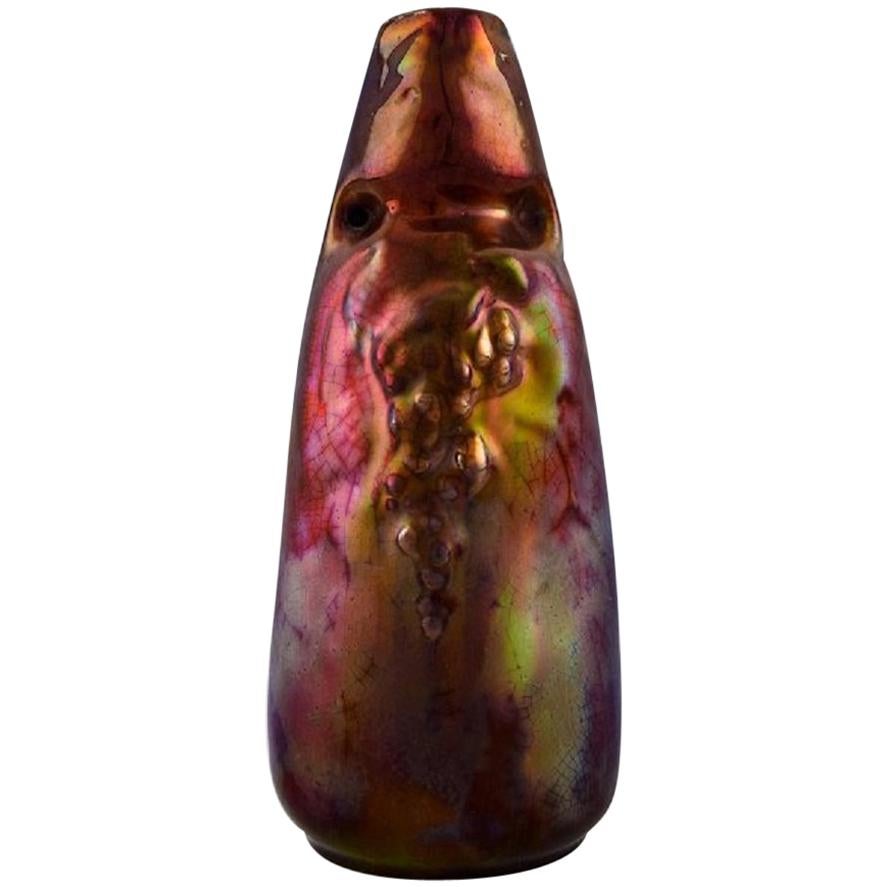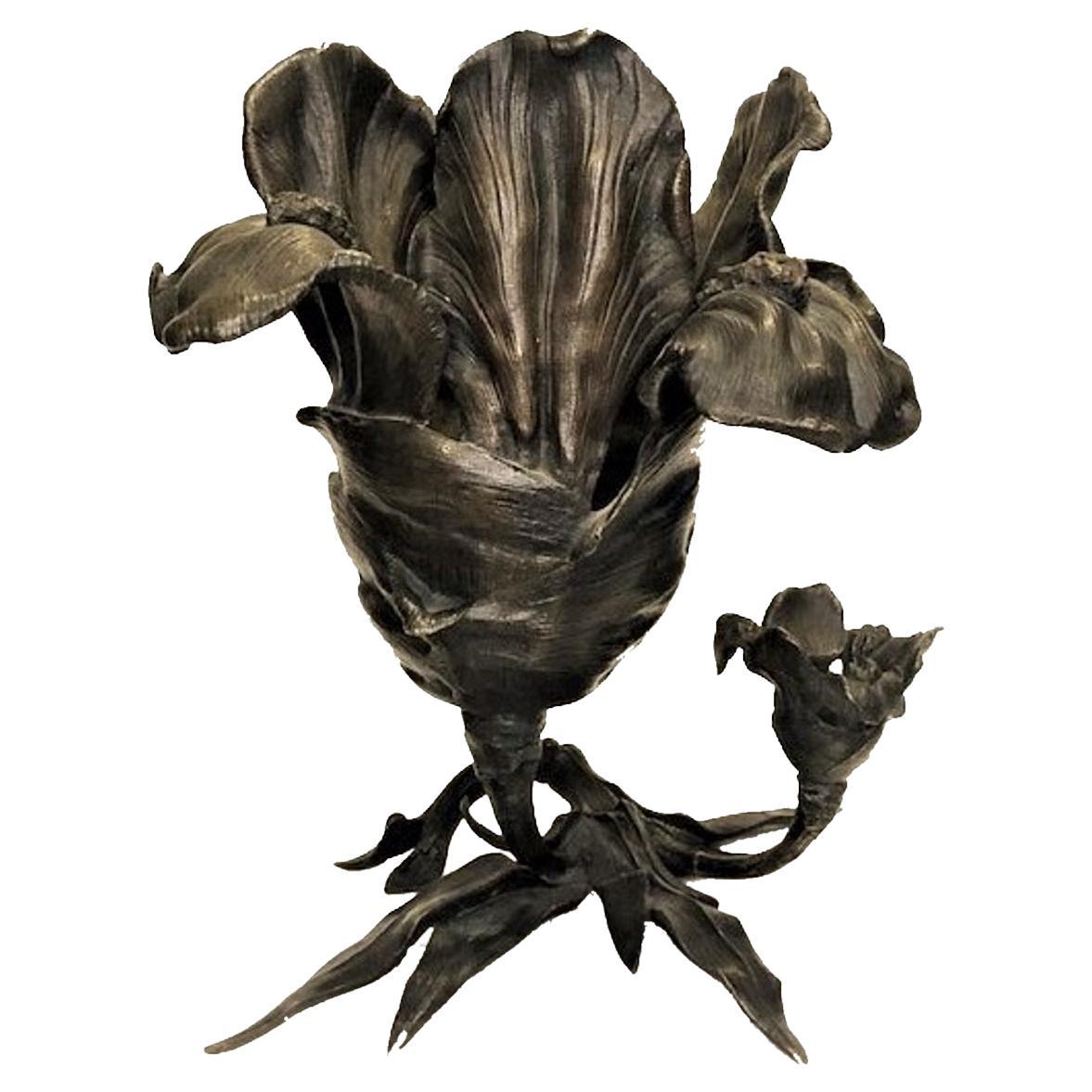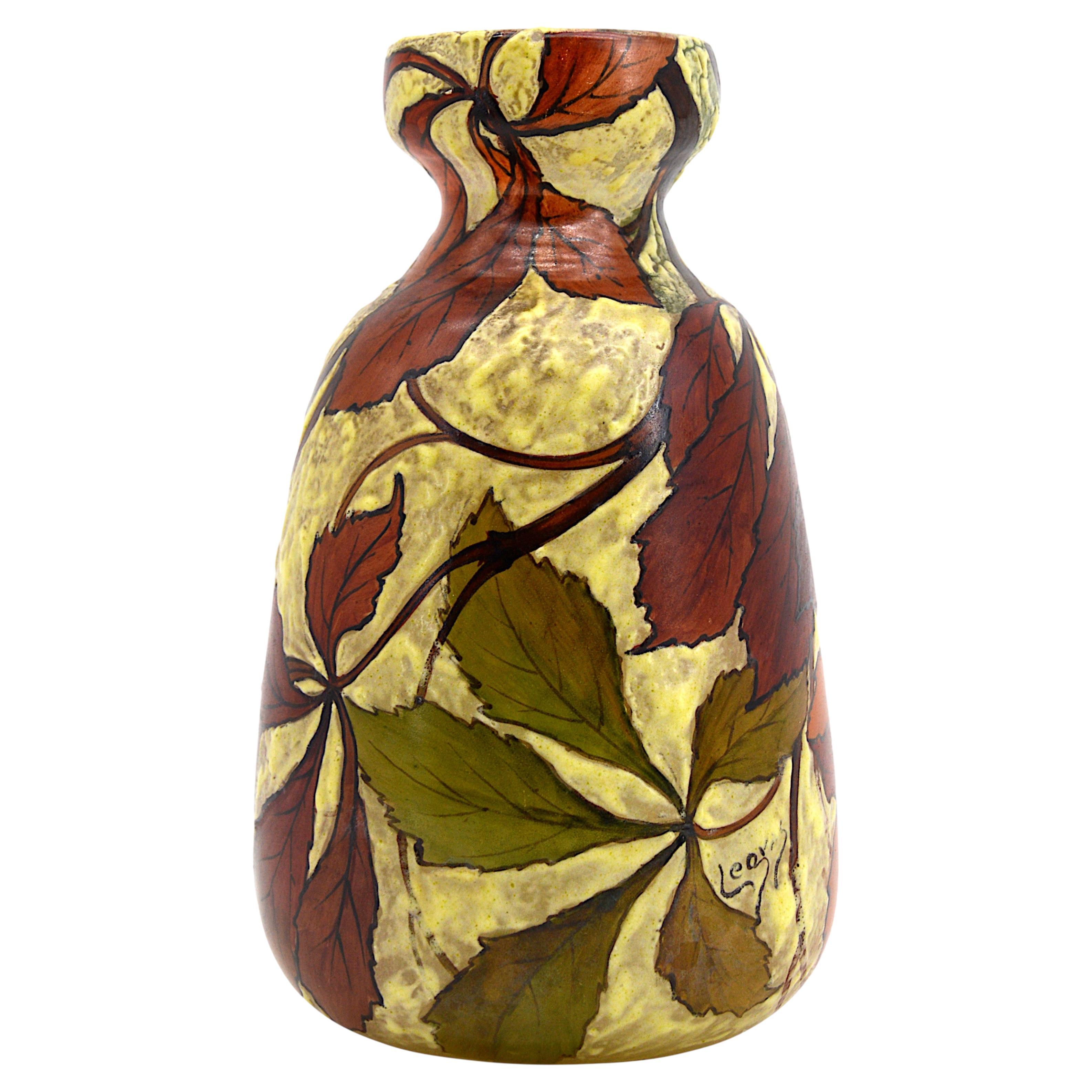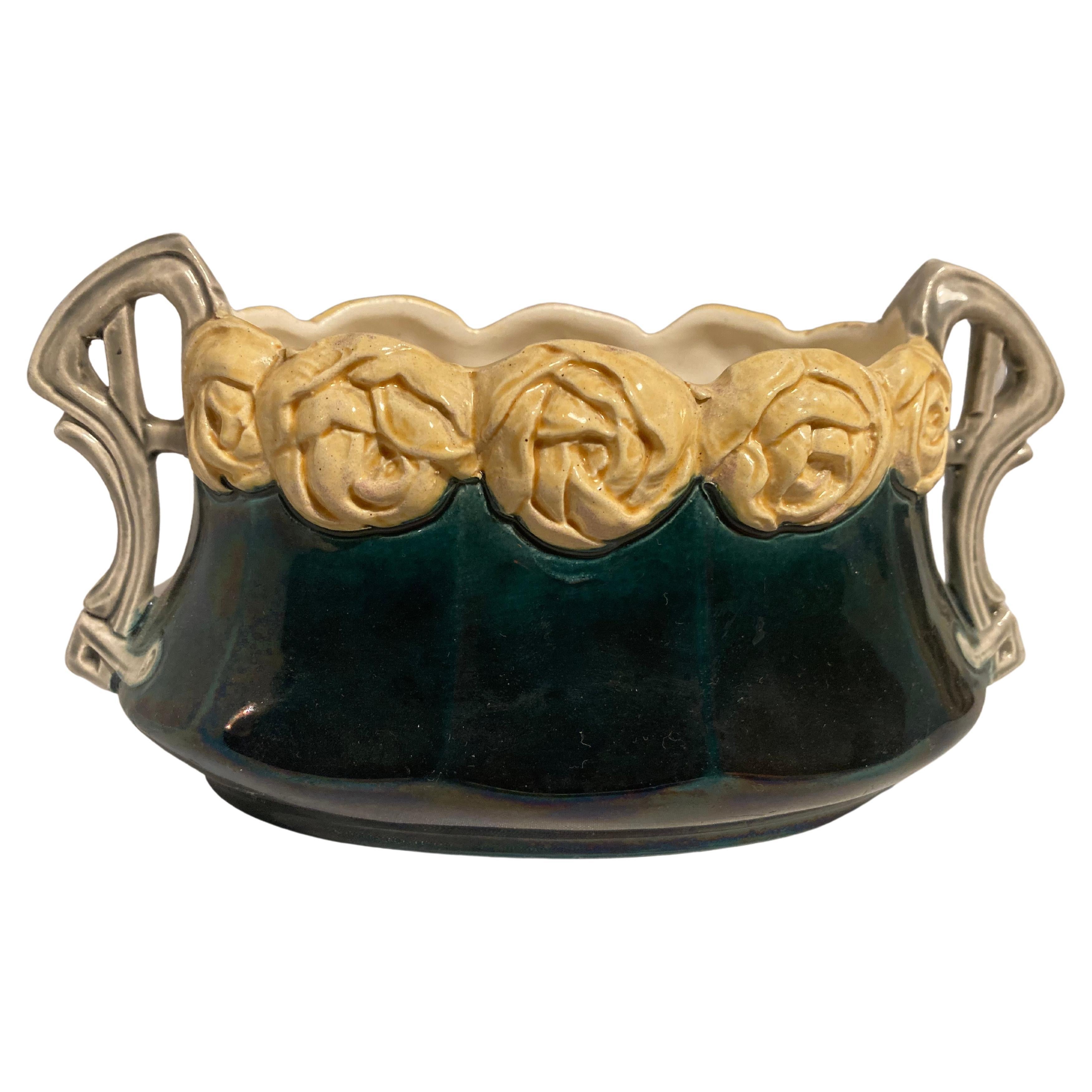Items Similar to French Art Nouveau Iridescent Stoneware & Bronze Vase or Cachepot, ca. 1900s
Want more images or videos?
Request additional images or videos from the seller
1 of 11
French Art Nouveau Iridescent Stoneware & Bronze Vase or Cachepot, ca. 1900s
About the Item
French Art Nouveau
Ocean Life Theme
Vase Cachepot
Iridescent Stoneware & Patinated Bronze Crab Appliqué
ca. 1900s
ABOUT
We present here a most unusual and utterly decorative French Art Nouveau Iridescent Stoneware Vase or Cachepot w/ Ocean Life Theme & Bronze Crab Appliqué, created ca. 1900s. This piece of art features an absolutely outstanding composition depicting a stormy sea wave carrying a crab on its crest.
DIMENSIONS
Height: 14 inches
Width: 9.75 inches
Depth: 12.5 inches
- Dimensions:Height: 14 in (35.56 cm)Width: 9.75 in (24.77 cm)Depth: 12.5 in (31.75 cm)
- Style:Art Nouveau (Of the Period)
- Materials and Techniques:
- Place of Origin:
- Period:1900-1909
- Date of Manufacture:ca. 1900
- Condition:Wear consistent with age and use. We make our best effort to provide a fair and descriptive condition report. Please examine photos attentively for they are an important part of the description. Send us a message to request more details or discuss price.
- Seller Location:New York, NY
- Reference Number:1stDibs: LU2819336720242
About the Seller
5.0
Vetted Seller
These experienced sellers undergo a comprehensive evaluation by our team of in-house experts.
Established in 1993
1stDibs seller since 2017
68 sales on 1stDibs
Typical response time: 2 hours
- ShippingRetrieving quote...Ships From: New York, NY
- Return PolicyA return for this item may be initiated within 10 days of delivery.
More From This SellerView All
- French Art Nouveau Patinated Bronze Sculptural Iris Vase, ca. 1900Located in New York, NYABOUT IRIS The iris is a special and mysterious flower. Not only because of its striking appearance, but also from an artistic and historical point of view. It is also like a work of art, as though created by Mother Nature. The unique leaves of this plant not only create wonderful shadow casts, but also look as if they were painted by hand. It's no wonder that iris acts as the muse for countless artists, and can be seen in many famous works of art. The iris was first spotted in the time of Pharaoh Thutmose, in 1504 BC. He had the iris inscribed into the wall reliefs of a temple as a sign of his power, as well as decorating his sceptre with motifs of the flower. Since then, the iris has been a symbol of victory in Egypt. But the symbolism of the iris goes further than that. In Japan, the flower represents courage and is the symbol of the boys' festival. In Islamic cultures, the iris is a symbol of prosperity. In Europe, the flower was a popular weapon symbol in the Middle Ages and stood for chivalry. And in Christianity, the iris was seen as a symbol of the trinity because of its three-part flowers. With more than 300 varieties, the iris is now the most popular flower among growers and gardeners following the rose. Countless artists use the iris in their works and the flower is present in all eras. You can see the flower on furniture, vases, jewelry, fabrics, sculptures, coats of arms and much more. Did you know that the iris is also called the sword lily? It's not a coincidence that it used to symbolize physical and emotional pain and suffering caused by a weapon. We also see the flower in religious art, where it's often associated with Mary and Jesus. The iris is also associated with the Greek goddess Iris, where the flower symbolizes reconciliation and divine messages. This is also reflected in many paintings. Finally, the iris is also visible in Dutch and Flemish still-life paintings. This can be in a religious form, incorporated into an object or as a decorative flower. In the Art Nouveau art movement, the iris (along with other plants, such as the birch) was often used as an expression of feminine beauty. With its almost otherworldly appearance, the iris is perfectly suited to the Art Nouveau aesthetic and is featured in many well-known works of art. The poet of that era, Hermann Hesse...Category
Antique Early 1900s French Art Nouveau Planters, Cachepots and Jardinières
MaterialsBronze
- Japanese Art Nouveau Awaji Ware Art Studio Pottery Flower Vase, ca. 1900sLocated in New York, NYJapanese Art Nouveau Flower Vase Awaji Ware Art Studio Pottery ca. 1900s ABOUT AWAJI WARE ART STUDIO POTTERY Awaji pottery was made on the Japanese island of the same name between...Category
Antique Early 1900s Japanese Art Nouveau Vases
MaterialsPottery
- Charles Vital-Cornu, French Art Nouveau Bronze Sculptural Floral Vase, 1900sBy Charles Vital-CornuLocated in New York, NYCharles Vital-Cornu (French, 1851 - 1927), Jouffroy’s and Pils’ pupil, he acquired a skillfulness mastery in carving marbles and producing bronzes. He used several patinas in his production. Indeed, if his pieces' embodiments are often golden-brown colored, the hollow part are darker. His figures, hands, faces, and bodies are of a great quality. Charles Vital-Cornu had participated in numerous annual ‘‘Salons’’ organized in Paris by ‘‘la Société des Artistes Français’’ where he got several awards, such as a mention of Honor in 1880 and 1881, a third class medal in 1882, a travelling grant in 1883, a second class medal in 1886, a bronze medal at the 1889 World Fair and, finally, a silver medal at the 1900 World Fair at the Grand palace...Category
Antique Early 1900s French Art Nouveau Vases
MaterialsBronze
- Paul Loiseau-Rousseau, French Art Nouveau Gilt Bronze Jug, Ca. 1900By Paul Loiseau-Rousseau 1Located in New York, NYPaul Louis Emile Loiseau-Rousseau (French, 1861-1927) was a famous French sculptor. In his youth, he planned to devote himself to etching, was a student of Antoine-Louis Barye at the...Category
Antique Early 1900s French Art Nouveau Vases
MaterialsBronze
- After Loetz, Bohemian Jugendstil Iridescent Art-Glass Flower Vase, ca. 1900By Loetz GlassLocated in New York, NYThis large elegant, museum quality flower vase was probably made by Johann LOETZ Witwe Glassworks (Klostermühle, Bohemia, circa 1900) is a superior example of Jugendstil ~ Art Nouveau luxury object. The semi-translucent art glass strikes a spectator not only with the uniqueness of its surface, reminiscent of crocodile skin, but also with unexpected color scheme - a combination of dark brown, old gold and green, covered with craquelure; against the background of iridescent violet. The vase is framed by outstandingly designed bronzed & patinated pewter mounting, consisting of simple large handles, almost geometric-form; with one wreath of leaves, crowning the neck; and the second, forming a base. The simplicity of the forms both, the glass vessel and the mounting are generating extremely interesting decorative effects, inherent exclusively to Jugendstil ~ Art Nouveau era. LOETZ Witwe Glassworks In 1836, Johann Eisner established a glassworks in the Southern Bohemian town of Klostermühle, today part of the Czech Republic. The Art Nouveau Period was the glory years of the company. The glassworks created large numbers of its own new designs of iridescent, trailing art nouveau glass, sometimes in collaboration with well-known artists and designers like Marie Kirschner and Franz Hofstötter (aka Franz Hofstätter). The company’s success during this period had two prime drivers – the technical expertise of Prochaska and the business acumen of von Spaun. Loetz Witwe created many of its own designs, and also supplied glass commissioned by major customers like E. Bakolowits (Vienna) and Max Emanuel...Category
Antique Early 1900s Czech Art Nouveau Vases
MaterialsArt Glass
- Japanese Art Nouveau Meiji Period Patinated Bronze Vase, circa 1900Located in New York, NYAlthough unmarked, this rare and important, grand but at the same exquisite patinated bronze vase has just a very few little details, defying the shape of the handles, as well as the...Category
Antique Early 1900s Japanese Art Nouveau Vases
MaterialsBronze
You May Also Like
- Montieres Art Nouveau Iridescent Ceramic Vase, Early 1900sLocated in Copenhagen, DKMontieres Art Nouveau iridescent ceramic vase. Early 1900s. Measures: 20 cm x 9 cm. Stamped. In perfect condition.Category
Early 20th Century French Art Nouveau Vases
- Legras French Art Nouveau Enameled Vase, Early 1900sBy François-Théodore LegrasLocated in Saint-Amans-des-Cots, FRRare French Art Nouveau vase by François-Théodore Legras, France, Early 1900s. Very very rare vase with an uncommon shape showing a decor richly enamelled with chestnut leaves. A mus...Category
Antique Early 1900s French Art Nouveau Glass
MaterialsArt Glass
- Small French Art Nouveau Barbotine Jardiniere, 1900sBy Hector GuimardLocated in Köln, NWSmall french Art Nouveau Barbotine Jardinière in the style of Hector Guimard. Very finely worked. Delicate form. very rare. Numbered and marked on...Category
Antique Early 1900s French Jugendstil Planters, Cachepots and Jardinières
MaterialsMajolica
- Iridescent Iris Art Nouveau Cachepot by Clement MassierBy Clement MassierLocated in Chicago, USAn encounter with Massier’s luster-glazed ceramics is an embarkation on an acid-colored trip, the sort of exploration which inspires deep reflection and requires transparency. Clemen...Category
Antique Early 1900s French Art Nouveau Vases
MaterialsEarthenware
- 1900s Pair of Art Nouveau Ceramic Neapolitan VasesBy Guido CacciapuotiLocated in Catania, SiciliaTwo rare Art Nouveau ceramic vases made in Italy in 1900. They depicting two children playing. Signs of use and age visible on the photos.Category
Antique Early 1900s Italian Art Nouveau Vases
MaterialsCeramic
- Large Art Nouveau French Pottery Iridescent Flambe Vase, circa 1900Located in New York, NYImpressed mark of Alphonse Cytere who established the Rambervillers art studio in 1903. Also marked Unis France.Category
Early 20th Century French Vases
Recently Viewed
View AllMore Ways To Browse
Collection Blue And White Vases Collection
Gaetano Pesce For Fish Design
Skier Vase
Pair Vases Neoclassical
Cobalt Blue Vases Antique
Large Blue Japanese Vase
Jingdezhen China
Different Chinese Vases
German White Porcelain Vase
White German Porcelain Vase
Vintage Scheurich Pottery
Germany Orange Vase
Vintage Brown Stoneware Vase
Japan Glazed Blue Vase
Sevres Lid
Sevres Lidded
Ceramic Urn Pair
Poured Glass Vase





